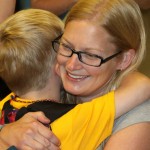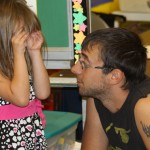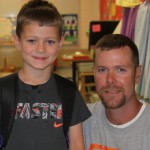Schools encourage positive behavior
By Angie Landsverk
When John Erspamer became the principal of Waupaca Learning Center, he was surprised by the number of reactive decisions he made throughout the school day.
“I was reacting to behaviors,” he said. “I thought there had to be something better than what I’m doing with the kids.”
Four years ago, Erspamer went from being a principal at Waupaca High School to a principal at one of the district’s two elementary schools.
At a conference that school year, Erspamer learned about Positive Behavioral Interventions and Supports (PBIS).
“One of the things with PBIS is expectations are across the board for everyone, whether it’s a teacher or custodian,” he said.
PBIS is a national, research-based program. It involves developing a common language and also common consequences for behavior.
After attending the conference, Erspamer asked Scott Van Ess if he was interested in becoming the school’s PBIS coordinator.
“Scott was teaching fourth grade,” Erspamer said. “I liked the way he handled his classroom.”
After Van Ess agreed to do so, he went through training and put the school’s Tier I team together.
The state provides training for PBIS, and schools then implement it the way they want to, Van Ess said.
At WLC, the Tier I team took words from the school’s original and former Rascal Code to identify the values it wanted to focus on at the school.
Those four values are to be respectful, responsible, safe and prepared.
This school year, those values are now being called “The Waupaca Way” throughout the school district.
The district’s schools are transitioning from having separate school colors and mascots to incorporating the high school’s color (blue) and mascot (Comets).
It is part of having a common language and identity throughout the school district.
“Scott and the PBIS Tier I team did the bulk of work in identifying those four core values,” Erspamer said.
The Tier I team of 15 to 20 people includes teachers from each grade level, the school’s two guidance counselors, the PBIS coordinator, Erspamer, Title I staff, support staff and parents. They meet monthly.
“Research shows that it’s not enough to just give kids a great educational background,” Van Ess said. “They need social skills to succeed. PBIS is creating a caring and structured environment.”
Whether they are in a classroom, standing outside a restroom, on the playground, in the commons or in a hallway, students know what those expectations are.
Posters use words and photos to demonstrate the four core values in each of those places.
“We want everyone to be on the same page,” said Van Ess, who is now dean of students at Waupaca High School.
Jody Pankratz, who was a teacher at Waupaca Middle School, is the new PBIS coordinator at WLC.
How it works
Just as the district has interventions for students who need help academically, PBIS provides interventions for those needing help socially.
“Behavior and academics go together. If a child is struggling with behavior at home or in school, the child is usually struggling with academics, too,” Van Ess said.
Some students feel they have no value, he said.
“A lot of kids feel like they weren’t born and meant to be successful or do great things,” he said.
For those students, they feel they just need to survive and get through another day, Van Ess said.
“So when they come into our schools, we want them to know it is a place where they can be successful,” he said. “You have to recognize positive behavior.”
They use a matrix to teach students what it means to be respectful, responsible, safe and prepared in all school settings, Van Ess said.
Ben Rayome, the principal at WMS, said the basis of PBIS is teaching positive behavior versus harping about negative behavior all the time.
“You’re supposed to have four, five, six positives to every negative,” Erspamer said of recognizing behavior. “Research says when you are around positive behavior, you will see more positive behavior.”
When Van Ess received training about PBIS, he also received training in the School Wide Information System (SWIS), a database which allows schools to track behaviors.
Positive behaviors result in recognition with tickets now being called “Comet Cash” throughout the district.
As one example, students at WLC may turn in tickets to eat lunch with Erspamer.
At WHS, students will be able to earn a pizza party.
Erspamer said the SWIS database allows them to identify the time, place and type of behavior and use that data to pinpoint where they need to reinforce or reteach the expectations.
The Tier I team is the first level of intervention.
The second level of support is the Tier II team.
That team meets every Monday to see what additional assistance is needed for children who are struggling.
It also involves having staff members who check on students who need additional support.
Erspamer said those students do that with someone who is not their classroom teacher.
In addition, a national mentoring program called Kid’s Hope USA has a presence at WLC.
The mentors meet once a week with students who are identified as needing extra intervention, he said.
Van Ess said it typically takes three to five years to fully implement PBIS.
This school year, WLC is ready to train its Tier III team for another level of support and intervention.
Three years ago, WLC began implementing PBIS.
The middle school then began to do so, followed by the high school.
Now Chain O’ Lakes Elementary is ready as well.
“We’re not assuming they have the social skills they need. We want to make sure they have what they need to be successful,” Van Ess said.
The results
At WLC, they saw immediate results after implementation of PBIS began, Van Ess said.
“Scott and these teachers here are the credit for why it works,” Erspamer said. “The results show we are seeing more positive behavior.”
Van Ess said at WLC and WMS, they have seen a reduction in the frequency and intensity of behaviors that interrupt learning.
Erspamer said overall, they are more proactive in dealing with disruptive scenarios.
The school’s PBIS coordinator goes into classrooms throughout the year to reinforce the four core values.
There are also daily teachings within the classroom.
Kindergarten teacher Faye Klismet and fourth-grade teacher Amy Lemkuil are members of the Tier I team.
“It has brought the whole staff together,” Klismet said.
She said students hear and see the message.
Lemkuil said it builds friendships within the classrooms, as children want to be recognized not only for the good things they do but also the good things their classmates do.
“I have noticed a difference in the amount of discipline I have to enforce,” she said.
At WMS, Dean of Students Chad Pritzl said portions of PBIS were in place when he started there five years ago.
“This year, we’re implementing Tier II and getting training for that portion,” he said.
Pritzl said the program gave the middle school a common language.
“Students and staff know what is expected of them. It also encourages staff to be proactive, to set conditions for positive behavior and reinforce positive behavior as well,” he said.
He said businesses in community are also being supportive of the program by offering items for the system which rewards positive behavior.
“It takes 50 tickets to get a pizza reward,” Pritzl said. “Kids are surprisingly good at delayed gratification, and they’ll team up too and share their tickets.”
Ultimately, the middle school will also have a Tier III team to ramp up the support for students who need it, Rayome said.
What’s next
With WLC and WMS further into implementation, Van Ess said they will be able to look at how PBIS is affecting academics.
Erspamer said more schools throughout the state are implementing PBIS.
With about 660 students at WLC and a staff of about 130, he credits Van Ess and the staff for the success the school is seeing.
“The success of PBIS at WLC is a direct correlation to the staff. They’ve taken on the challenge, and it’s been a united effort,” Erspamer said. “Everybody doing their small part is what makes it work.”
He wants the momentum to continue.
Families received car window stickers at registration that say “The Waupaca Way!” and include the four core values.
District staff hope families use the same words at home.
Erspamer envisions a day when he sees a billboard on U.S. Highway 10 with the words on it and signs under the city’s population sign.
“It can be retaught by parents and community members,” he said. That’s the goal – to get everybody living ‘The Waupaca Way,’ and it starts with the students.”
This is the first in a two-part series. Next week’s Waupaca County Post will examine how the Waupaca Area Public Library and Waupaca Parks and Rec are implementing “The Waupaca Way” in their programs.






